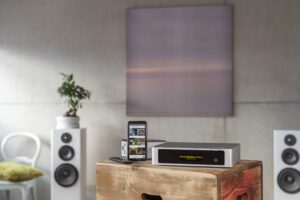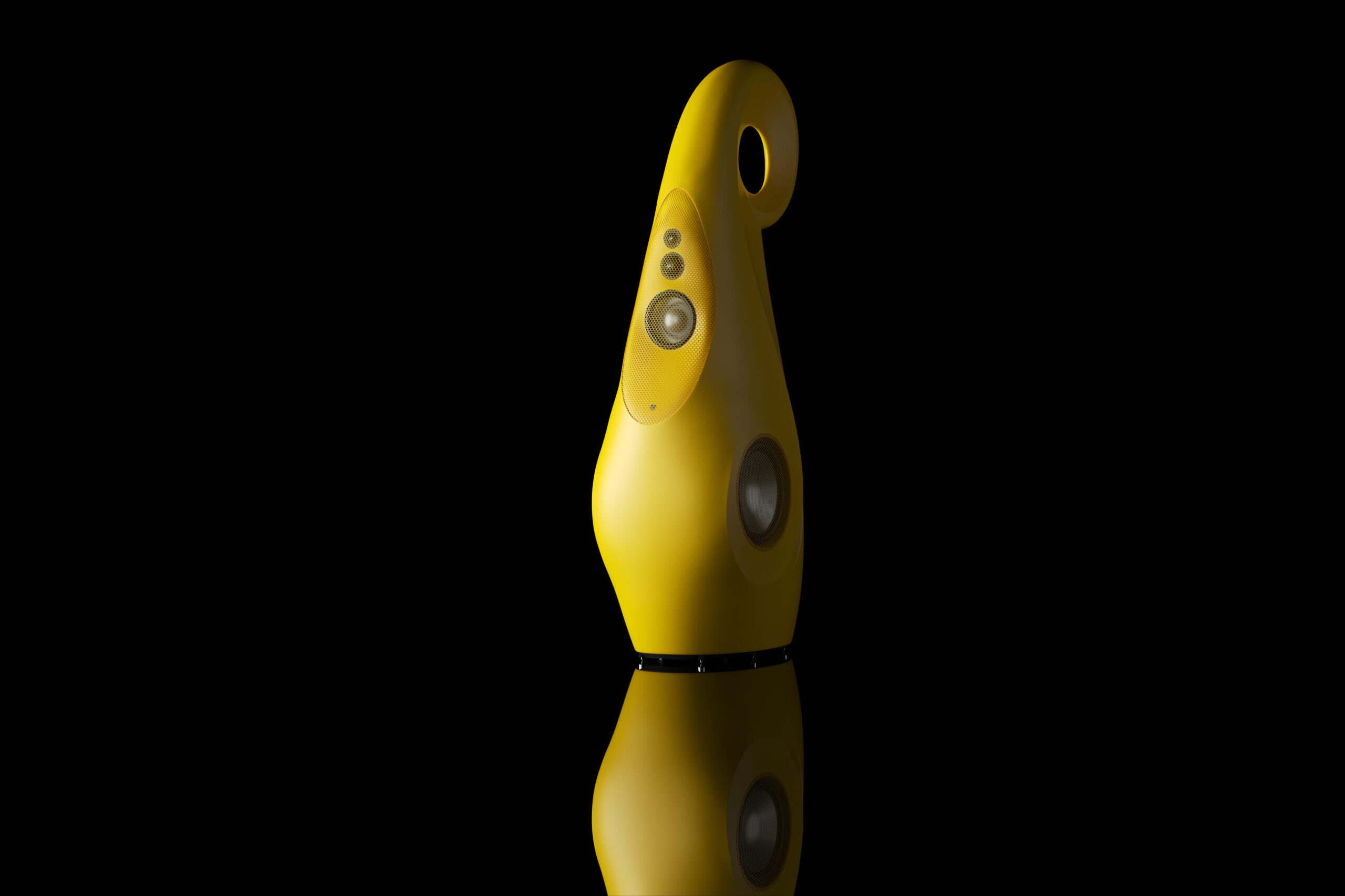
I managed to get away to Greece in late July last year, just as it was reaching Greek temperatures in the UK, and enjoyed two weeks of proper ‘scorchio’ weather. I noticed how much hotter the towns were (even in the shade) than the less densely populated areas, especially those without buildings. This is largely because the roads and buildings soak up heat and then slowly release it over the day. This is what high-mass cabinets do, albeit at a different frequency; they store the energy that comes from the drive units and release it over time, rather more time than it takes for the signal to be produced by the drivers. The heavier the loudspeaker cabinet, the more extreme this can get even if heavy speakers do have a solidity in the bass that quite appealing for the same reason.
With most wooden cabinets the energy is directly radiated by the panels of the box to some extent, the better the bracing the lower the radiation appears to be the rule. Vivid takes a wholly different approach to controlling radiation by making the cabinet as stiff and light as possible. The Giya G1 Spirit is a large speaker that stands just over five foot high and has a volume of 180 litres but it weighs less than 70 kilos. A Bowers & Wilkins 802, by comparison, is more than a foot shorter and weighs nearly 90 kilos.
Two skins
The Vivid Giya cabinets are made from two skins of vacuum-infused glass-reinforced composite, a sophisticated variant on fibre glass, with end grain balsa between the two skins to provide stiffness. A few manufacturers make bass drivers in a sandwich arrangement like this but they use foam as the filling; a speaker cabinet needs something a bit more solid. The distinctive shape of Giya is not a whim of the Vivid styling department but a genuine instance of form following function. The tubular ring at the top represents the end of the inverted horn that absorbs energy from the two bass drivers on either side of the cabinet. This is very similar to the tapered tube concept that Vivid designer Laurence Dickie created for Bowers & Wilkins in the original Nautilus loudspeaker, which has subsequently found its way into the 800 series models.
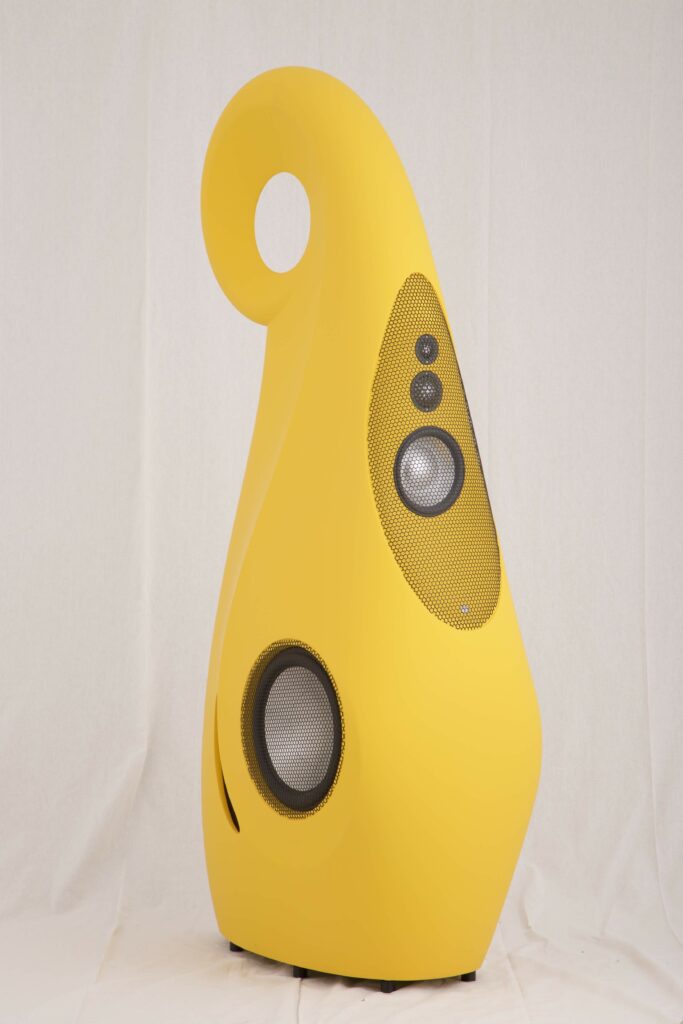
In Vivid loudspeakers, this tapered tube system is used with all the drivers. You can see where those for the tweeter, upper- and lower-midrange drivers terminate on the back of the cabinet where small hex bolts are visible. The bass drivers which produce the most energy and are thus most likely to vibrate the cabinet, are not fixed to it in the usual way. Instead they are physically braced against one another and held in place with a compliant mounting where the chassis meets the cabinet, this is an approach found in some of the better subwoofers, and I note, a concept speaker that Monitor Audio showed in Munich High-End 2022, and means that the bass system is solidly anchored with minimal risk of transmitting energy into the ‘box’.
This is still a reflex-loaded loudspeaker however; it’s just that like the bass drivers there are two reflex ports that look a bit like gills and sit opposite one another either side of the cabinet behind the bass drivers. This arrangement is used in order to balance the ports and let the bass system breathe evenly.
Breaking up the chain
Vivid develops and makes its own drive unts. This is the only way that Dickie could use domes that are not conventional hemispheres, instead they have a catenary shape which is the shape a chain forms when it’s hung between two posts. This shape was chosen because its break up point is notably higher than a regular dome even before you add the carbon fibre reinforcing ring to its perimeter. If Vivid’s measurements are to be believed, and Dickie is a first-rate engineer, the catenary shape has such clear advantages over regular domes that one wonders why no one else uses them, perhaps there’s a patent at work here.
The lower midrange is perhaps the most unusual driver on the Giya G1 Spirit, it has a large oblate sphere (doughnut shaped) central dome and very steep cone sides. The large central dome indicates that this 125mm driver has a 75mm voice coil, which is a rare ratio. Like the domes above it this driver has a carbon fibre reinforcement ring at the base of the dome, an arrangement not seen on any other driver including those in the Vivid range.
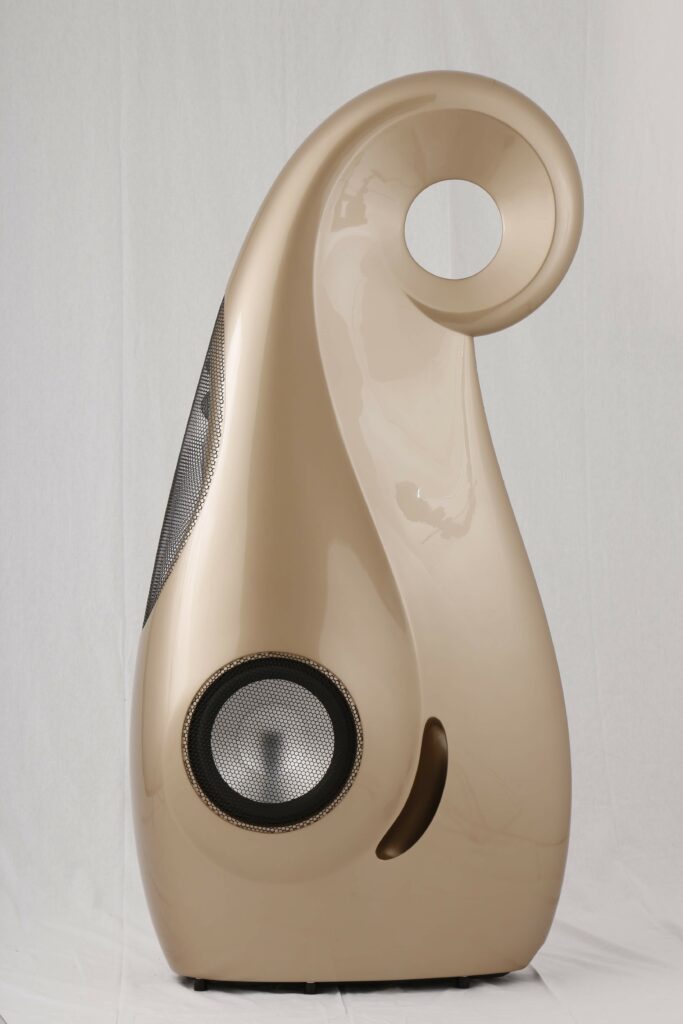
The G1 Spirit is available with a conventional onboard crossover or a separate outboard one. The latter comes in a relatively conventional rectilinear case made of the same material as the speaker, so it’s good and shiny with chamfered corners. Connection to the loudspeaker is via an umbilical that fixes right underneath the speaker, with the onboard crossover the cable terminals are also underneath the speaker. This makes for a very neat appearance but requires that the speaker be laid on its side in order to make the connections, which is true in both onboard and outboard crossovers. The advantage of the latter is easy speaker cable connection and less vibration for the crossover components to cope with, however it was originally conceived to allow the G1 Spirit to be actively driven, and this has been done with electronics from Linn, Devialet and Trinnov in the past.
Clean living
The sonic character of this loudspeaker is very distinct, inasmuch as it appears to have virtually none of its own. And yet because this is so much more obviously the case than with most other loudspeakers it really stands out. The first thing that hits you is that nothing hits you except the music, that is there are no sharp edges, no sense of grain or distortion. Dickie disagrees with that last word and prefers the term ‘coloration’ because that is the correct term, however the Giya G1 Spirit doesn’t just sound as though it has an even tonal response, it sounds as though it doesn’t have the sharp edges found with the vast majority of loudspeakers. If anything it is very much like an electrostatic, it has the same smoothness and ease as the best examples of the genre but this is combined with the low end power and dynamics of a reflex design.
It’s a speaker that warrants high quality and well matched amplification, I was able to offer this to an extent but not the full extent so suspect that even with the incredible results I got there is more to be heard from these extraordinary loudspeakers. Nonetheless having them in the system proved to be a totally revelatory experience the like of which I have rarely had the pleasure of. There is a good variety of very open sounding loudspeakers on the market today, the more advanced designers take into account the fact that you can’t get an even response in a normal room unless the sound that hits the side walls, floor and ceiling has the same balance as the direct sound from drivers to your ears. This wide dispersion approach requires great driver design and a cabinet that doesn’t hinder energy coming off those drivers in all directions, the Giya G1 Spirit cabinet is devoid of sharp edges so the signal has nothing to reflect off as it exits the speaker. This reduces sensitivity to an extent but also reduces coloration to a much greater extent, this speaker’s sensitivity is actually quite high at 92dB (2.83 VRMS at 1m) and its nominal impedance a relatively easy six Ohms. So Vivid has managed to keep coloration down without sacrificing ease of drive which is a rare achievement in itself.
Wide Dispersion
The wide dispersion is presumably one reason why this speaker sounds so relaxed, not the primary reason but a factor. It’s also why the image scale changes with every piece of music played, in fact everything about every recording played through the Giya G1 Spirit seems to be revealed. Give them a good acoustic recording such as Chasing the Dragon’s Mendelsohnn Octets and the sense of being there is more than palpable, it’s totally convincing. You get the openness of the high ceiling at the Henry Wood Hall where the recording was made and you get the timbre of the eight instruments layered and dare I say it, vivid, in front of you. What also struck me about this and many other pieces of music is how well the Vivids track level, that is the volume level of individual voices and instruments relative to one another in a given mix. Described as micro dynamics this is an area where the ultra low noise (because there is so little cabinet vibration) of these speakers puts them into another league. It allows the listener to follow and appreciate different performers within a group and to hear the way that different elements of a mix have been treated.
If that all sounds rather dry what it boils down to is a degree of transparency that is exceptional, and that means that more of the musical signal gets into the room without being colored or distorted. With Mari Samuelsen’s first solo album Mari [DG] it means that a large group of musicians appears in the room by some means of magic, the degree of realism is positively uncanny. This is a spectacular recording but just how spectacular became a lot clearer with the big Vivids, I’ve never heard string tone that’s so natural nor had a sense of the scale and nature of a studio acoustic that was so well reproduced. It makes the music she creates that much more powerful and moving, and it makes me realise that the Rega P10 turntable is even better than I thought it was, and I was pretty impressed in the first place.
With less natural recordings in the form of Frank Zappa’s live You Can’t Do That On Stage Anymore [Zappa Music] releases, you can hear how he has built up these tracks using snippets from different performances, a guitar break here, a voice there. You can hear the joins but this does not get in the way of enjoying the brilliance of the music, Zappa had standards that not even his highly rehearsed bands could always live up to and by using the best bits spliced together he was able to construct the near as possible perfect concerts for those of us unable to attend the real thing. Having a loudspeaker that is capable of delivering that music at a suitable volume without any sense of effort and all of the bandwidth required is a very special experience that gets you as close as you can to being there.
Not a cartoon
The bass on the G1 Spirit is not obvious, that is like the rest of the bandwidth it doesn’t have sharpened leading edges that define it a bit like a cartoon. Rather the bass is three dimensional, it’s got depth and weight and moves with effortless speed. Essentially it’s extremely natural, and just as extended and powerful as the signal demands, so if that signal emanates from a synth or electric bass it can be very muscular indeed. But if it’s a piano or double bass there is more texture and depth of tone, more variety and colour. Whatever the source it’s very juicy and appealing and always bang on time.
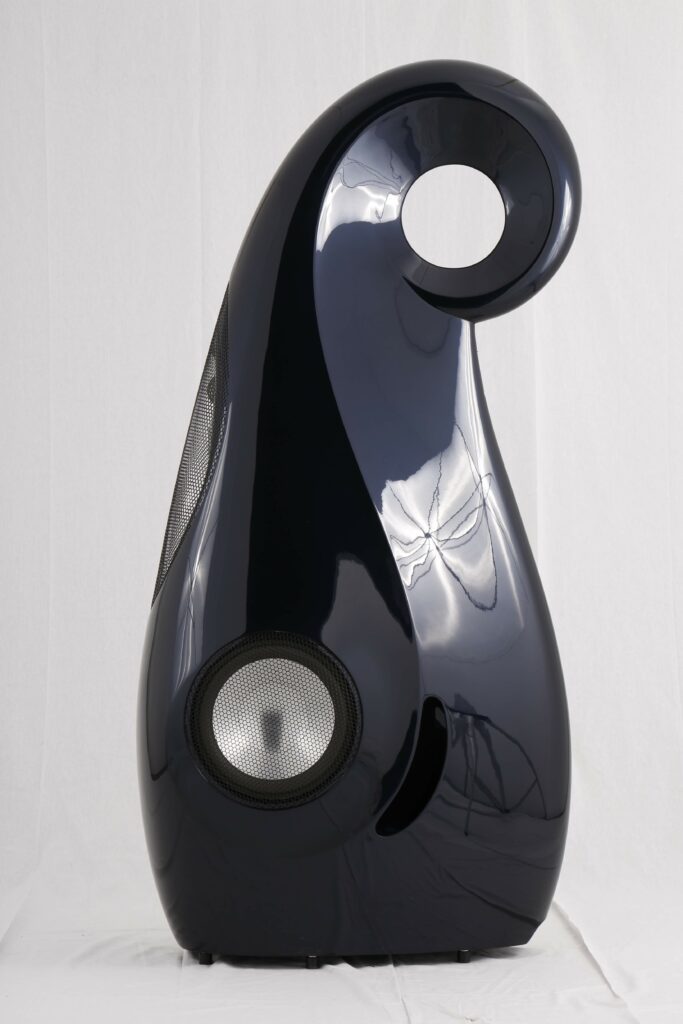
The Vivid Giya G1 Spirit is an exceptional loudspeaker, thanks to the way that its drivers and cabinet have been executed it doesn’t have the problems associated with 99.9% of dynamic loudspeakers. Instead you get sound that’s as exciting, powerful and beautiful as the recording permits, and many of them permit an awful lot of all three. It’s a speaker that I could all too easily live with right up to the point where enthusiasm needed to be summoned for another loudspeaker review. It’s not a speaker for reviewers, it’s a speaker for music lovers who don’t have to make comparisons.
Technical specifications
- Type 4-way, five-driver, reflex loaded floorstanding speaker
- Driver complement One 26mm metal dome tweeter with Tapered Tube loading; one 50mm metal dome midrange driver with Tapered Tube loading; one 125mm alloy/carbon diaphragm lower-mid driver with 75mm voice coil, two 225mm alloy diaphragm bass drivers with 100mm voice coil in 45mm gap
- Crossover frequencies 220Hz, 880Hz, 3.5kHz
- Frequency response + / -2dB 29–33,000 Hz
- Impedance 6 Ohms nominal, 3 Ohms minimum at 20 kHz
- Sensitivity 92dB @ 2.83 VRMS at 1 m on axis
- Dimensions (H×W×D) 1600 × 440 × 820mm
- Weight 67.4kg/each
- Finishes Piano black, Pearl white, Oyster matte plus premium colours
- Price £82,500/pair
Manufacturer
Vivid Audio
Distributor
Vivid Audio UK LTD
Tel +44(0) 1403 713 125
By Jason Kennedy
More articles from this authorRead Next From Review
See all
PrimaLuna EVO 100 phono preamplifier
- Apr 22, 2024

Reiki Audio SuperSwitch Master Pro + Servant Pro
- Mar 27, 2024

Melco Audio N1-S38 music server
- Mar 27, 2024









